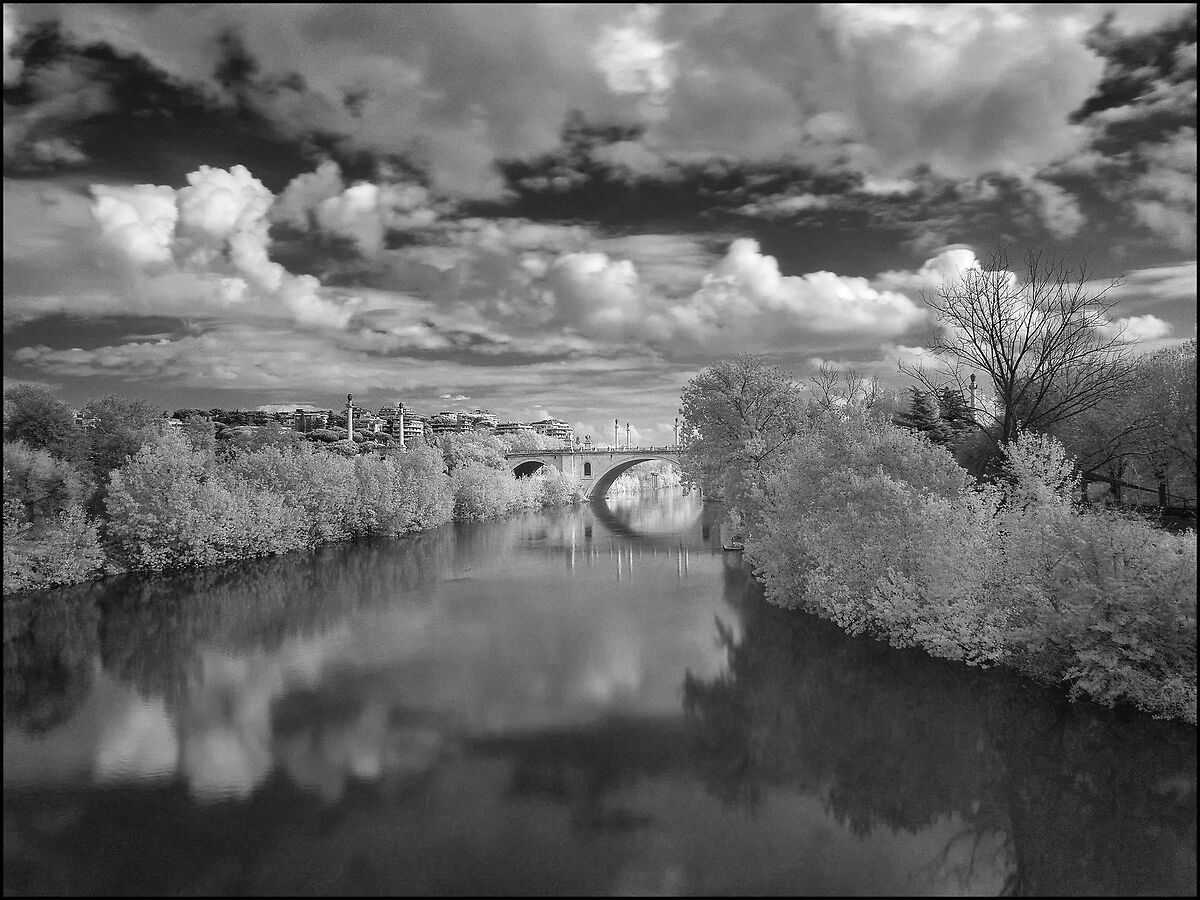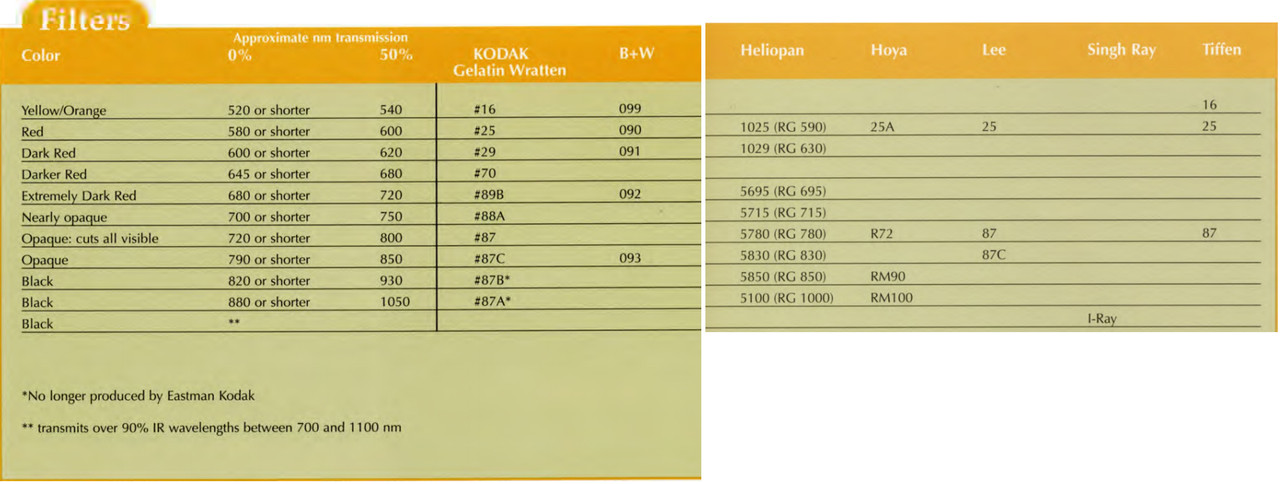| inviato il 19 Luglio 2020 ore 17:25
Macchinosa ni, tanto quanto un buon BN. Considera che se hai un buon WB già il JPEG e' accettabile bello e pronto. Oggi ho avuto modo di giocarci per bene ed e' uno spasso! Cambiando filtro, cambiavo impostazione di WB er voila' macchina pronta live per la nuova modalità!
Poi pubblico i jpeg senza post. |
| inviato il 19 Luglio 2020 ore 20:44
Riesci a far tutto con i jpeg? Io lavoro i raw e quindi diventa tutto un po' lungo. Oddio, una volta capito il meccanismo, si fa, però non è che sia un lavoro immediato. Usi Photoshop o altro?
|
| inviato il 19 Luglio 2020 ore 22:55
L'hai fatto a scopo più scientifico o estetico? |
| inviato il 19 Luglio 2020 ore 23:52
Fotografico, lo scopo scientifico non mi interessa, motivo per cui ho scartato gli UV.
Comunque se interessa il genere ci si può cominciare a cimentare con treppiede e filtro esterno (Hoya R72 con taglio IR a 720nm) alla macchina normale e pose più lunghe. Esempio, stessa macchina non modificata:

www.juzaphoto.com/galleria.php?l=it&t=3636536
|
| inviato il 20 Luglio 2020 ore 10:22
“ Poco e niente. Se setti bene il bilanciamento del bianco, poche cose e via. „
Mah, forse col 720nm si riesce in jpeg, ma io, che uso prevalentemente il 590nm, nonostante faccia il bilanciamento del bianco già in macchina, se non scatto in raw e non passo poi per Camera Raw, ho dei risultati molto discutibili  |
| inviato il 20 Luglio 2020 ore 10:32
“ Fotografico, di scientifico non mi interessa, motivo per cui ho scartato gli UV. „
C'è pure un filone di fotografia all'ultravioletto a fini non scientifici, per esempio la peculiare ritrattistica (rigorosamente monocromatica); solo che gli UV sono molto meno "maneggevoli" rispetto all'IR. Solo il filtro da mettere davanti all'obiettivo costa un tot; poi gli obiettivi, ah, gli obiettivi... ecco un usato:
www.ebay.com/itm/Mint-Nikon-UV-NIKKOR-105mm-f-4-5-AIS-Lens-w-Caps-HK78 . |
| inviato il 22 Luglio 2020 ore 16:42
Un bell'articolo sul filtro IR CHROME dell'ultimo scatto a colori:
www.diyphotography.net/the-ir-chrome-infrared-filter-is-a-digital-vers
“ I filtri da 46mm sono molto piccoli e li ho messi impilati in un due tappi metallici della Gobe, così da poterli portare appresso senza problemi anche in bici „
Volevo spendere due parole sulla scelta fatta. I filtri costano e averli di più diametri soprattutto grandi costa una follia. E la scelta di modifica a spettro pieno, io ho tagliato gli UV ma cambia poco, costringe ad usarli sempre. Invece con una macchina IR a modifica “secca” ad esempio a 850nm o il più classico 720nm, consente di montare tutte le ottiche e via però di contro non permette una grande libertà. Avendo sperimentato per anni l'IR economico ma limitato, avevo già filtri 720nm per i diametri principali delle mie ottiche: da 62mm, 72mm, etc. e per gli intermedi potevo usare gli anelli di step up. Quindi l'uso per il solo IR con taglio a 720nm per tutte le altre ottiche (m.zuiko 12-40 f2.8 62mm, 12-100mm f4 72mm etc. che vanno tra l'altro benissimo senza hot spot) mi è consentito senza spese ulteriori con una modifica dual/full spectrum. Non potrò fare IR850nm, false colour spinti ma posso accentarmi. A limite, dovesse piacermi particolarmente qualche filtro del set da 46mm “economico”, potrei decidere di acquistare uno o due filtri al max per diametri maggiori (che costano moltissimo). Intanto faccio esperienza per qualche anno e vedo cosa mi piace di più. Per ora l'IR850nm con BN puro.
|
| inviato il 22 Luglio 2020 ore 20:47
Ci sono un po' di cose che non mi sono chiare...
1. Ora la tua macchina legge su tutto lo spettro luminoso e se vuoi la limiti tu con i filtri? È così?
2. Quando si parla di filtro da 720 nm, si intende che registra (passano) le lunghezze d'onda <720 o >720? Cioè il visibile e l'UV passano o no?
3. Gli alberi rossi perché sono rossi? Se registra fuori dal visibile, perché dovrebbero essere rossi?
|
| inviato il 22 Luglio 2020 ore 21:09
1. Si quasi, gli UV sono comunque tagliati via nel filtro residuo messo davanti al sensore (quello di serie taglia sia gli UV che gli IR, ovviamente non totalmente tanto è vero che con pose lunghe e un filtro IR davanti si possono far arrivare IR in dose apprezzabile). Comunque si, l'idea è quella.
2. col filtro IR 720nm passano le lunghezze d'onda maggiori di 720nm quindi niente di visibile (in realtà un pelino si è lo si nota), degli UV non lo so (potrei chiedere al produttore) ma neppure mi interessa dato che sono segati pesantemente a livello di filtro sul sensore.
Questi i filtri IR che ho preso nel kit da 46mm (il 720 in realtà lo avevo già nella misura da 46mm e comunque ce l'ho per altri diametri):
590nm Infrared : qui passa una buona fetta di spettro visibile 590-700nm
665nm Infrared : qui passa una parte di visibile 665-700nm
720nm Infrared : si è già detto
850nm Infrared : qui di visibile manco l'ombra, però dato che è il filtro che taglia di più luce, e' anche quello che fa perdere più stop
medicinaonline.co/2017/03/09/differenza-tra-raggi-infrarossi-ultraviol
3. No, sono verdi (ho anche scatti normali dello stesso luogo) ma il filtro IR CHROME è un filtro che lavora sia sulla parte visibile che IR (ma taglia via gli UV, quindi lavora allo stesso modo sia su una macchina full spectrum che su una dual spectrum) e altera le componenti cromatiche in modo da replicare la risposta della pellicola (v. articolo citato in cui si compara la foto fatta dalla Nikon F3 caricata a pellicola kodak Ektachrome con la digitale Canon Eos 6D Mark ii e filtro della Kolari Vision in cui si vede che hanno fatto un buon lavoro). |
| inviato il 22 Luglio 2020 ore 22:58
Grazie per i chiarimenti.
Sempre sulla 3: ho capito che gli alberi sono rossi perché alla Kodak decisero di rendere gli infrarossi come rossi e la Kolari ha seguito quella scelta.
Senza IR CHROME ma, diciamo, con un 720, riprendendo a colori, gli alberi di che colore verrebbero? Verde chiarissimo quasi bianco?
4. Di quanto bisogna aumentare (mediamente) l'esposizione, diciamo con il solito 720, in un paesaggio rispetto ad una ripresa normale con sensore non modificato? |
| inviato il 22 Luglio 2020 ore 23:08
Si, quasi bianco, nessun verde, al limite un leggero giallino, con una piccola differenza rispetto all'850nm. Guarda qui, si comprende bene il tutto:
kolarivision.com/articles/choosing-a-filter/ (*)
Per gli stop con macchina normale, sono tipicamente almeno sei o sette a 200 ISO, non ricordo con esattezza. Comunque se hai soggetti fermi (foglie alberi senza vento), vuoi lisciare l'acqua e avere il mosso delle nuvole con vento in quota, diciamo che ti risparmi i filtri ND, quindi va pure bene. Ovviamente treppiede necessario. Però sei limitato nelle scelte espositive.
(*) Choosing an Infrared Filter
kolarivision.com/articles/choosing-a-filter/
Filter Choices
We currently have 7 filters to pick from. We offer the 720nm standard infrared, 850nm deep infrared, 665nm extra color infrared, 590nm infrared, a full spectrum filter, a two spectrum filter, a Blue-IR NDVI filter, and an H-alpha Astrophotography filter.
The Standard IR Filter (720nm) This is the tried and true classic IR filter. It allows some visible light for false color, and good contrast for black and white. This is equivalent to the Hoya R72 and Wratten 89b.
When to use this filter: This filter is good if you are interested in shooting some mild color and black and white. This filter produces the traditional dark blue skies and can also be processed for color. While not as high contrast as the 850nm, people prefer this filter over the 850nm for B+W work, as it allows a little more color for B+W processing.
The 550nm IR Filter: Inspired by false color IR film, the 550nm lets in the most visible light of all our filters creating deep blue skies and blood crimson reds.
When to use this filter: Like the 590nm but with a twist, this filter is excellent for producing attention grabbing landscapes. It's also a surprisingly good choice for infrared portraits, since it maintains more neutral skin tones than the 590nm without exposing veins and still providing striking false color.
The Ultra Color filter (590nm) The Ultra Color filter (590nm) lets more visible light in, producing the most vibrant colors. Leaves are golden yellow, and skies are bright blue. B+W contrast is lower than the deeper IR filters.
When to use this filter: This filter is good for vibrant color IR landscapes, allowing the most flexibility in post processing. Also a good choice for portraits. The shallow IR shows less veins than the deeper IR filters while still creating a dreamy look. May not be as sharp as the deeper filters do to increased chromatic aberration.
The Extra Color filter (665nm) The Extra color filter (720nm) has an effect between the 720nm and 590nm, producing more vibrant colors than the 720nm for pale yellow leaves and brighter blue skies.
When to use this filter: My most used filter, this filter is best suited for processing to a traditional blue sky and white leaves, by desaturating the yellow in the leaves. This produces a look like the 720nm filter, but providing a richer blue that comes out more reliably between different cameras and different shooting conditions. Also a good choice for portraits. The shallow IR shows less veins than the deeper IR filters while still creating a dreamy look. May not be as sharp as the deeper filters do to increased chromatic aberration.
The Deep Black and White filter (850nm) This filter is good for a dedicated black and white IR. The camera and will produce bright whites and pronounced darks. With a custom white balance in camera, the picture is close to pure B+W without any processing. Equivalent to the Wratten 87c.
When to use this filter: This filter is the best for the highest contrast B+W, closest resembling traditional B+W IR film. Also good for forensics and other applications where the deep IR wavelengths are helpful.
The NDVI Blue IR filter (Blue +IR) Our newest filter transmits both blue and IR, making it ideal for NDVI crop analysis applications, allowing an NDVI to be generated from a single image using the blue and red channels of the image. This filter is also handy for landscape photography, as it produces a similar effect to the 590nm after a channel swap, right out of the camera.
When to use this filter: Good for crop analysis purposes and a false color IR without post processing. Due to the multiple bands the lens has to focus with this filter, the images are less sharp than they can be with the dedicated IR filters.
The Full Spectrum filter (clear glass) makes the camera sensitive to UV, visible, and IR light, allowing switching between various external filters to achieve the desired effect, this allows going between infrared and regular shooting with one camera, however on DSLRs opaque infrared filters will block composition.
The Two Spectrum filter (IR + Visible) makes the camera sensitive to visible and IR light. It works the same way as the full spectrum, while filtering out UV for better color rendition in visible light shooting.
Considerations for choosing an infrared filter
The first consideration is deciding if you will shoot color or not. If you plan to shoot only B&W then the 850nm filter is the best choice. If you will shoot even occasional color, then you will need to go with the 720nm filter or below. When choosing between the 590nm, 665nm, and 720nm, the first consideration is your aesthetic preferance. If you like the yellow leaf effect, you would need to go with the 590 or 665nm option. If you would like to shoot regular color shots, with white leaves and blue skies, then the 720nm filter is probably right for you.
Pros and Cons of the 590nm and 665nm filter
With these enhanced color filters, you will have an increased color range to work with. With processing, it is possible to desaturate photos from these two filters to look like the 720nm image. This adds some more flexibility when shooting, and allows for good color results in some shooting situations that would not work so well with the standard 720nm filter. Some cameras don't have very good color results with the 720nm filter, such as the Nikon 5400 and some Canons Powershots, so the 665nm filter can overcome this effect. Another really nice benefit with these filters is that you can use higher cutoff IR filters over them. For example, with a 665nm conversion you could use a 720nm, 850nm and still take handheld pictures that will look exactly like the higher cutoff filter. You couldn't use any lower filter though, like the 590nm filter. If the camera you are converting has live view, this is an easy way to take advantage of both the color and B&W aspects of IR.
A downside to these two filters is that they have less contrast for B&W images. Another downside is that cameras will have a harder time setting a white balance with the enhanced color filters. These filters can be more unpredictable, yielding different results depending on camera model and shooting conditions. See our article on How DSLRs and Compacts handle Color. Another thing to watch out for, is that the 590nm and 665nm filter can be a little less sharp than the 720 and 850nm filters. Since they let a wider spectrum of light in, there are more chromatic aberrations and a bit softer focus.
Considerations for point and shoot cameras
On most compact cameras the replacement filters need to be very thin and will leak more visible light, so 590, 665, and 720 filters can produce duller color. The 800 and 850 filters will also leak a little visibe light. They will still be monochromatic but they may be red or blue tinged and require processing.
To achieve a good false color effect with the 590 and 665 filters, a custom white balance is crucial. You should not order these filters if your camera does not have a custom WB option. Also, just because your camera has a custom white balance setting, does not guarantee that you can achieve images like above with these filters. Camera white balances were not made to work in infrared, and the camera may not be able to measure a white balance properly leaving you with unexpected results. 590 filters have the most trouble with this.
If your camera does not have a custom white balance option, the 850 filter still work for B&W photography. The 720 filter can still be used to get good false color results even with automatic white balance, although the results are not quite as reliable.
Full Spectrum
The full spectrum, or clear filter, does not have many distinct uses on its own, but rather it gives you the flexibility to switch between different external infrared filters and still shoot handheld. It makes the camera sensitive to visible, infrared, and UV light. See our Full Spectrum article to see when you should consider full spectrum as an option.
Two Spectrum
Two spectrum is our new unique conversion that makes the camera sensitive to visible and infrared light and blocks UV light. If you do not plan to shoot UV, this is the best option and gives better color rendition for visible light photography. See our Two Spectrum article to see when you should consider a two spectrum conversion as an option. |
| inviato il 23 Luglio 2020 ore 0:50
Ma perché mi vuoi attaccare questa scimmia? :) |
| inviato il 23 Luglio 2020 ore 8:19
Comunque, per non svenarsi, tutti i filtri si possono trovare anche a prezzi umani, cercando soprattutto su ebay. Io, basandomi sulla scheda che allego, mi sono fatta un bell'equipaggiamento comprando filtri vintage.

Purtroppo, questo non vale per il filtro IR CHROME. Però, scattando in raw e giocando un po' con i canale colore, si possono ottenere risultati simili o comunque molto interessanti, almeno a mio parere
www.juzaphoto.com/galleria.php?l=it&t=2642457
E comunque, prima o poi l'IR CHROME lo comprerò 
|
Che cosa ne pensi di questo argomento?Vuoi dire la tua? Per partecipare alla discussione iscriviti a JuzaPhoto, è semplice e gratuito!
Non solo: iscrivendoti potrai creare una tua pagina personale, pubblicare foto, ricevere commenti e sfruttare tutte le funzionalità di JuzaPhoto. Con oltre 242000 iscritti, c'è spazio per tutti, dal principiante al professionista. |

Metti la tua pubblicità su JuzaPhoto (info) |


 JuzaPhoto contiene link affiliati Amazon ed Ebay e riceve una commissione in caso di acquisto attraverso link affiliati.
JuzaPhoto contiene link affiliati Amazon ed Ebay e riceve una commissione in caso di acquisto attraverso link affiliati.